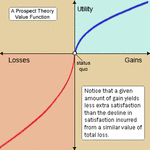http://en.m.wikipedia.org/wiki/Heuristics_in_judgment_and_decision-making#Attribute_substitution
And so it goes that numerical ratings are subjective and relatively inaccurate for comparing bike to bike. Long-term user experience and comments and anecdotal data can be more essential than the initial numerical assessment from Court. Access is available for all here to gain a perspective on the value of e-bikes and their usefulness to individual lifestyles.
Since the EBR community has access to this forum, we have an outlet to add our input and experience. That finally is what makes EBR a tremendous benefit to the e-bike consumer.
Daniel Kahneman won a Nobel prize in economics for his work in mathematical psychology. Kahneman truly revolutionized stock investment with
Prospect Theory.
The key is: "
rather than the final outcome" -- or rating. More important are heuristics -- mental shortcuts people take to cope with overwhelming complexity.
If you read Thinking, Fast and Slow, economic behavior becomes more clear. How to best use resources like EBR.com is one tool towards a high-ticket purchase.
For me, the issue is life-style change. I want to minimize the role a car plays in my life. I want to keep car mileage below 5,000K miles. The eBike is my primary tool for that life style change. Today, I run two miles to the store and carry 30+ pounds of food for the health and environment benefits.
One heuristic related to overall ratings is "
Anchoring":
"Anchoring and adjustment is a heuristic used in many situations where people estimate a number.[27] According to Tversky and Kahneman's original description, it involves starting from a readily available number—the "anchor"—and shifting either up or down to reach an answer that seems plausible"
Anchoring also causes particular difficulty when many numbers are combined into a composite judgment. Tversky and Kahneman demonstrated this by asking a group of people to rapidly estimate the product 8 x 7 x 6 x 5 x 4 x 3 x 2 x 1. Another group had to estimate the same product in reverse order; 1 x 2 x 3 x 4 x 5 x 6 x 7 x 8. Both groups underestimated the answer by a wide margin, but the latter group's average estimate was significantly smaller.
[33] The explanation in terms of anchoring is that people multiply the first few terms of each product and anchor on that figure.
[33] A less abstract task is to estimate the probability that an aircraft will crash, given that there are numerous possible faults each with a likelihood of one in a million. A common finding from studies of these tasks is that people anchor on the small component probabilities and so underestimate the total.
[33]
In 2002 Daniel Kahneman and Shane Frederick proposed a process called attribute substitution which happens without conscious awareness. According to this theory, when somebody makes a judgment (of a target attribute) which is computationally complex, a rather more easily calculated heuristic attribute is substituted.[45] In effect, a difficult problem is dealt with by answering a rather simpler problem, without the person being aware this is happening.[42] This explains why individuals can be unaware of their own biases, and why biases persist even when the subject is made aware of them. It also explains why human judgments often fail to show regression toward the mean.[42][45][46]
Affect heuristic - Perhaps the most important
"
Affect", in this context, is a
feeling such as fear, pleasure or surprise. It is shorter in duration than a
mood, occurring rapidly and involuntarily in response to a
stimulus. While reading the words "lung cancer" might generate an affect of
dread, the words "mother's love" can create an affect of
affection and comfort. When people use affect ("gut responses") to judge benefits or risks, they are using the affect heuristic.
[40] The affect heuristic has been used to explain why messages
framed to activate emotions are more persuasive than those framed in a purely factual way.
[41]
Let's take the
opposite viewpoint, that of a bike marketer of high-end bikes. Should you
worry about Storm Sonder's low cost bike? I would be quaking in my boots. Why? Because the largest market segment is
ANCHORED on price. Convincing this market segment about other
ATTRIBUTES is a very difficult sell. Other cascading mental proceeses kick in due to the structure of the human brain. The Affect and Attribute heurisitics are reinforced in a cascading manner.
I do not know if Storm Sonders aspires to be the Henry Ford of eBikes, but he follows the Ford strategy.
These are only a few of the many more reasons why I use a Google Sheet to compare bikes.
The following graphs illustrate Prospect Theory. The graphs illustrate why people have much less resistance towards purchasing a Storm vs. a high-end bike.
More info at this blog
(Link Removed - No Longer Exists) (Link Removed - No Longer Exists)
A "StarPlot" to diagram the Benefits (i.e., words beginning with the letter E), Risk, Cost, Bias and overall Results.


